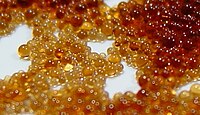
Photo from wikipedia
Dear editor We read with interest the recent article by Yousefi et al “Comparison of activated charcoal (AC) and sodium polystyrene sulfonate (SPS) resin efficiency on reduction of amitriptyline oral… Click to show full abstract
Dear editor We read with interest the recent article by Yousefi et al “Comparison of activated charcoal (AC) and sodium polystyrene sulfonate (SPS) resin efficiency on reduction of amitriptyline oral absorption in rat as treatments for overdose and toxicities” (1). While we commend the authors for studying the important issue of gastrointestinal decontamination, we have a few concerns with this study. First, it was unclear why the rats were euthanized at 60 minutes, allowing for only one amitriptyline concentration. If the study objective was to assess the efficacy of AC and SPS in reducing systemic absorption of AMT, the area under the concentration vs time curve (AUC) is needed to assess the total body burden of AMT. Further, Cmax cannot be determined using a single point in time. The information presented only allows evaluation of drug concentration after 55 min or 30 min of drug contact time. In fact it is possible that SPS delayed the peak and increased the total drug absorbed, which would be missed by their sampling method. Additionally, we question the use of SPS in actual patients without considering the possibility of inducing electrolyte imbalances. SPS is known to cause hypokalemia in eukalemic subjects (2). Given that sodium bicarbonate, the standard treatment for amitriptyline toxicity, shifts potassium intracellularly, combining the two modalities may further lower the potassium and place a patient at risk of QTc prolongation and Torsade de Pointes (TdP). Thus, we feel that it is premature to suggest that SPS is more efficient than AC for the treatment of overdosed humans. Extrapolation of their animal model is quite difficult with the limitations we have highlighted.
Journal Title: Iranian Journal of Basic Medical Sciences
Year Published: 2017
Link to full text (if available)
Share on Social Media: Sign Up to like & get
recommendations!